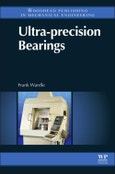Ultra-precision bearings can achieve extreme accuracy of rotation, making them ideal for use in numerous applications across a variety of fields, including hard disk drives, roundness measuring machines and optical scanners. Ultraprecision Bearings provides a detailed review of the different types of bearing and their properties, as well as an analysis of the factors that influence motion error, stiffness and damping. Following an introduction to basic principles of motion error, each chapter of the book is then devoted to the basic principles and properties of a specific type of bearing: ball, hydrodynamic, aerodynamic, hydrostatic and aerostatic. The book concludes with a comparison of these types of bearing and their applications.
Please Note: This is an On Demand product, delivery may take up to 11 working days after payment has been received.
Table of Contents
- List of figures and tables
- Preface
- About the author
- 1. Introduction
- Abstract
- 1.1 Benefits of ultra precision bearings
- 1.2 A systems approach
- 1.3 Bearing motion error
- 1.4 Static stiffness
- 1.5 Damping
- 1.6 The bearing as a dynamic machine element
- 1.7 Thermal characteristics
- 1.8 Closure
- 1.10 Notation
- 2. Ball bearings
- Abstract
- 2.1 Scope
- 2.2 Bearing sections
- 2.3 Bearing arrangements
- 2.4 Bearing tolerances
- 2.5 Ring fits and mounting parameters
- 2.6 Ball bearing load-deflection characteristics
- 2.7 Static stiffness characteristics of ball bearings
- 2.8 Damping in ball bearings
- 2.9 Motion error
- 2.10 Power consumption and thermal distortion
- 2.11 Life and reliability
- 2.12 Closing remarks
- 2.13 Appendix 2A, Vibration forces generated by waviness on the rolling surfaces of thrust bearing ball bearings
- 2.15 Notation
- 3. Hydrostatic bearings
- Abstract
- 3.1 Introduction
- 3.2 Bearing description
- 3.3 Basic operating principles
- 3.4 Pocket geometries
- 3.5 Hydrostatic bearing arrangements
- 3.6 Types of compensation
- 3.7 Approximate load capacity and static stiffness
- 3.8 Oil flow through a narrow gap
- 3.9 Temperature dependence of oil viscosity
- 3.10 Bearing load and deflection characteristics
- 3.11 Damping
- 3.12 Motion error
- 3.13 Power consumption and heat generation
- 3.14 Reliability
- 3.16 Notation
- 4. Aerostatic bearings
- Abstract
- 4.1 Introduction
- 4.2 Bearing geometries and arrangements
- 4.3 Principle of operation
- 4.4 Types of compensation
- 4.5 Approximate load capacity and static stiffness
- 4.6 Load-deflection analysis
- 4.7 Mass flow rate of air through an orifice
- 4.8 Mass flow rate of air through a porous insert
- 4.9 Grooved and recessed bearings
- 4.10 Porous air bearings
- 4.11 Air bearing static stiffness characteristics
- 4.12 Damping and dynamic stability
- 4.13 Motion error
- 4.14 Thermal characteristics
- 4.15 Reliability
- 4.17 Notation
- 5. Hydrodynamic herringbone and spiral grooved bearings
- Abstract
- 5.1 Introduction
- 5.2 Bearing types
- 5.3 Operating principles
- 5.4 Past developments
- 5.5 Load-deflection analysis of annular thrust bearings
- 5.6 Annular thrust bearing design examples
- 5.7 Radial load-deflection analysis of herringbone grooved journal bearings
- 5.8 Load capacity and static stiffness characteristics of herringbone grooved journal bearings
- 5.9 Damping and dynamic stability
- 5.10 Motion error
- 5.11 Thermal characteristics
- 5.12 Overview
- 5.14 Notation
- 6. Aerodynamic herringbone and spiral grooved bearings
- Abstract
- 6.1 Introduction
- 6.2 Bearing types
- 6.3 Past developments
- 6.4 Static load capacity and stiffness of aerodynamic annular thrust bearings
- 6.5 Design example
- 6.6 Static load capacity and stiffness of aerodynamic herringbone grooved journal bearings
- 6.7 Example of static stiffness and load capacity
- 6.8 Damping and dynamic stability
- 6.9 Thermal characteristics
- 6.10 Overview
- 6.12 Notation
- Index








